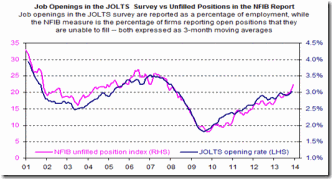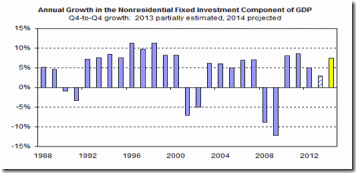Financial FAQs
We should be seeing a huge jump in economic growth this year. Why? Most economists are saying businesses are more optimistic with the federal budget agreement for 2 years, and no more tax increases hanging over consumers (and businesses). Republicans even finally agreed to spend $1.1 trillion this fiscal year—that is, until September when another fiscal year begins.
I maintain the increase in government spending, healthier state tax coffers, and a reviving housing sector with housing prices up 13.6 percent annually according the S&P Case-Shiller Home Price Index, will be the main reasons for faster growth and more job creation this year.
We know this because the Census Bureau’s JOLTS report now shows 4 million job openings, and a rising ‘quit’ rate, which means job seekers are feeling optimistic enough about their prospects to voluntarily leave their current job.
“After having risen by an average of 0.5 percent per month from the beginning of 2011 to the middle of 2013,” says Wrightson-ICAP, “the number of voluntary quits since July has climbed by 2.0% per month. The quit rate is important on two levels: it is both a general measure of worker confidence that tells us something about developments in the labor market, and it is a direct contributor to worker mobility, which is a key driver of productivity growth. (Matching workers to better jobs contributes to overall economic efficiency.)”
The best sign of an improvement in business optimism is the boost in capital expenditures. That expectation is based on a variety of factors, including the recent strength in the ISM factory orders index, a pick-up in capital spending plans by small businesses, and strong balance sheets and ample financing for larger companies. The capacity utilization data in Friday’s industrial production report reinforced that expectation. Total capacity utilization climbed to 79.2%, which is only one percentage point below the long-run (1972-2012) average that the Fed publishes as a reference point.
Wrightson-ICAP agrees with me on this, also. “As the aggregate level of capacity utilization rises, says Wrightson, many individual sectors are approaching or surpassing their previous cyclical highs. In the December data published last week, industries accounting for 33 percent of the Fed’s industrial production index had operating rates that were equal to or greater than their peaks in the previous cycle.
There are other factors, as well, such as the pickup in consumer spending with higher December retail sales, and consumer confidence. This could lead to a GDP growth rate in the mid-3 percent range for 2014, up from the average 2 percent growth rate of late. It is a huge jump and just reflects the pent up demand for everything, as household balance sheets are turning positive and businesses begin to spend the cash they have been hoarding.
So the Federal Reserve will probably continue with its tapering of QE3 purchases that will cause long term interest rates to continue to rise. But it’s still the beginning of this business cycle, believe it or not. And there is almost no inflation, which will keep interest rates from rising too fast.
Harlan Green © 2014
Follow Harlan Green on Twitter: https://twitter.com/HarlanGreen



No comments:
Post a Comment